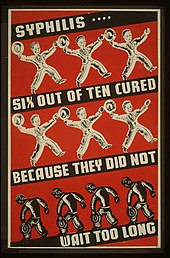
Tuskegee Airmen - is the popular name of a group of African American pilots who fought in World War II as the 332nd Fighter Group of the US Army Air Corps. The Tuskegee Airmen were the first African American military aviators in the United States armed forces. During World War II, African Americans in many U.S. states were still subject to Jim Crow laws. The American military itself was racially segregated. The Tuskegee Airmen were subject to racial discrimination, both within and outside the Army. Despite these adversities, they flew with distinction. They were particularly successful in their missions as bomber escorts in Europe.
The Tuskegee syphilis experiment[1] (also known as the Tuskegee syphilis study or Public Health Service syphilis study) was a clinical study conducted between 1932 and 1972 in Tuskegee, Alabama, by the U.S. Public Health Service. Investigators recruited 399 impoverished African-American sharecroppers with syphilis for research related to the natural progression of the untreated disease, in hopes of justifying treatment programs for blacks.[1]Tuskegee Airmen - is the popular name of a group of African American pilots who fought in World War II as the 332nd Fighter Group of the US Army Air Corps. The Tuskegee Airmen were the first African American military aviators in the United States armed forces. During World War II, African Americans in many U.S. states were still subject to Jim Crow laws. The American military itself was racially segregated. The Tuskegee Airmen were subject to racial discrimination, both within and outside the Army. Despite these adversities, they flew with distinction. They were particularly successful in their missions as bomber escorts in Europe.

No comments:
Post a Comment